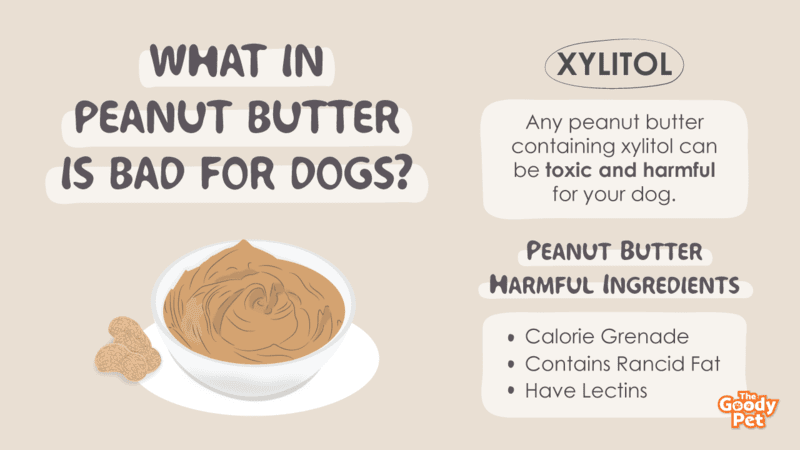Are you worried if you can feed your puppies peanut butter or not because they rush behind you every time you open the jar? So don’t worry, you’re not alone! It is what almost every dog owner is wondering. So, yes, you can let your dog eat peanut butter but in a moderate amount.
Xylitol is what peanut butter has and is bad for dogs. This key ingredient is an alternative to sugar and is commonly found in store-bought peanut butter. Also, you must avoid peanut butter high in fat and sodium content, as it can lead to diseases in dogs. A better alternative is homemade peanut butter.
You can use homemade peanut butter for a long-lasting treat inside a hollow bone or let your canines lick it from your finger or spoon to derive them nuts. However, at the same time, remember that an excessive amount of peanut butter can lead you to the dark side. So, make sure that you feed it to dogs in minimum quantity.
We will let you know how to counteract xylitol in dogs and what peanut butter can do to your puppy to avoid any inconvenience. We will also discuss its benefits and how much peanut butter you should let your dog eat. So, let’s dive deeper and collect all the valuable information.
Which Peanut Butter Your Dog Shouldn’t Eat?
Many vets and dog owners should have heard by now about peanut butter being an unhealthy food for dogs. Do you know why? It is because of xylitol! Any peanut butter containing xylitol can be toxic and harmful for your dog.
Xylitol is a sugar-replacing ingredient that most manufacturers are adding to peanut butter. It does not affect humans, but thousands of dogs are dying or getting sick because of xylitol.
What Are The Symptoms Of Xylitol Poisoning?
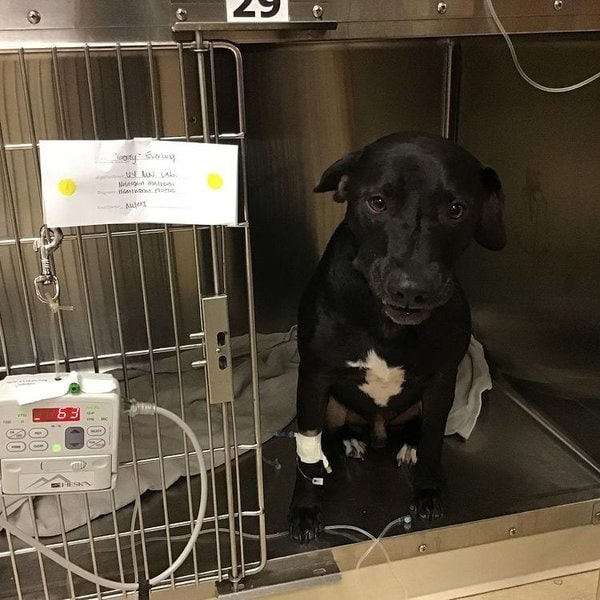
Unfortunately, if your pup has ingested the xylitol, the symptoms will start to develop within 30 minutes, or sometimes it may take up to 12 hours.
The most common symptoms of xylitol poisoning in dogs are listed below.
- Weakness
- Vomiting
- Lethargy
- Collapsing
- Limping while walking
- Liver failure
- Lack of coordination
- Lapse into coma
- Hypoglycemia
- Seizures
How To Prevent Your Dog From Xylitol Poisoning?
To counteract xylitol poisoning in your dog, make sure to check out the label on the peanut butter that you are buying. Moreover, dogs are habitual to eating or chewing almost everything they see. So, make sure to keep the products containing xylitol out of the reach of your puppy.
Secondly, in case your pup has already eaten the xylitol-containing product, then contact your vet straight away. Plus, don’t buy any product without reading its ingredients, especially the ones claiming that they are sugar-free. Xylitol is often used as a sweetener in sugar-free peanut butter.
Can Too Much Peanut Butter Be Bad For Dogs?
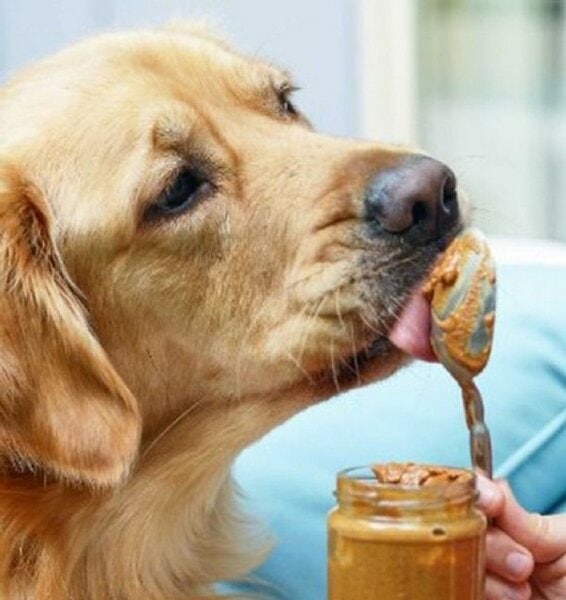
Peanut butter tastes good to dogs and has some health benefits, but it can bring about some health issues to your dog. It comprises rancid fats, dangerous mold, and some inflammation-causing ingredients, linking your dog to obesity risks and heart diseases.
Here are some ingredients included in peanut butter that can make your pup suffer from different diseases.
Calorie Grenade
As mentioned earlier, peanut butter does not comprise a balanced amount of nutrients, but it is a calorie-dense and inflammatory fat grenade. Moreover, if you let your dog consume an excessive amount of peanut butter, then your dog will surely gain weight unhealthily and will get inactive and lazy.
Contains Rancid Fat
You must know that omega-3 is essential for our dogs rather than omega-6, similar to fish oil fats. But, peanut butter contains omega-6 more in quantity than omega-3. It is an unbalanced quantity that can never be a friendly recipe for your dog.
Have Lectins
Peanuts contain lectins in them, so do peanut butter, and it is better to keep your dog away from lectins as much as possible. They create intestinal permeability and inflammation in your dog, which leads to arthritis and itchy skin. Moreover, due to inflammation and itchy skin, other opened-up auto-immune paths can cause heart diseases in your pup.
However, it does not mean that you will have to keep your furball in suspense. Remember that it is essential to serve peanut butter to your dog in a minimum amount and just as a treat. As long as you feed peanut butter to your dog cautiously, your dog can enjoy peanut butter until and unless it does not comprise xylitol in it.
How Much Peanut Butter Can Your Dog Eat?
As a starting point, try to limit the peanut butter servings to one teaspoon for a large or medium dog and ½ a teaspoon for a small dog.
Just because peanut butter is suitable for your puppy’s health doesn’t mean you can give it to them as much as you want.
Things To Keep In Mind While Feeding Peanut Butter To Your Dog
Firstly, you need to consider the calories in it and some factors mentioned here:
- Look for peanut butter without excessive salt or sugar.
- Check the ingredients and ensure that the peanut butter you’re purchasing for your dog is xylitol-free. It should not be even in small amounts.
- Make sure to keep the quantity moderate, don’t give too much peanut butter to your dogs.
- If your pup has food allergies, then consult your vet before letting it taste peanut butter.
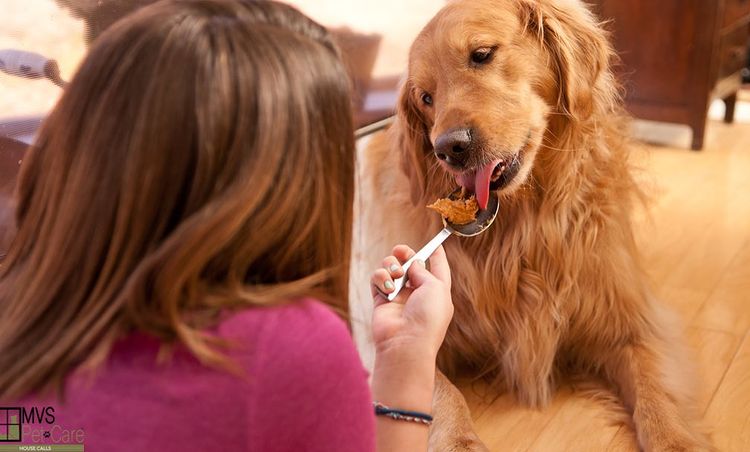
How To Safely Feed Peanut Butter To Dogs?
To feed peanut butter safely to your dog, here are some tips that you can follow:
- Spread a little amount of peanut butter on the dog toys or hollow bones. You can give it to your dog as a reward for its intelligence.
- Bake peanut butter dog treats for your pup. It will boost the energy of your dog and will make the canine enjoy its treats.
- Lastly, you can spread the peanut butter around the bathtub of your furball. It will make your pup peacefully enjoy the bath time, and you won’t have to run after the mischievous furball.
Noted these points? Now let’s see how much peanut butter is suitable for your dog.
High In Calories And Fat Content
Peanut butter is an energy-boosting spread, comprising around 180 to 200 calories in only two tablespoons. Moreover, even if you give a peanut butter treat to your canine, it would be as thrilling for it as an extensive amount.
You can feed peanut butter to your dog two times a day to help them with their cravings but not more than that. Moreover, you can only keep the quantity restricted to ½ to 1 teaspoon, depending on the size of your furry friend.
When Should Dogs Not Eat Peanut Butter?
If your dog is suffering from any medical issues or is overweight, it is better not to feed peanut butter.
Here, we have mentioned some cases when you should not feed peanut butter to your dog.
Overweight Dogs
If your dog is overweight and on a diet, it is not good to let the canine taste peanut butter. Because peanut butter contains fat, therefore, it will negatively affect your pup’s health. So, make sure to check your pup’s weight before adding anything fatty to its diet.
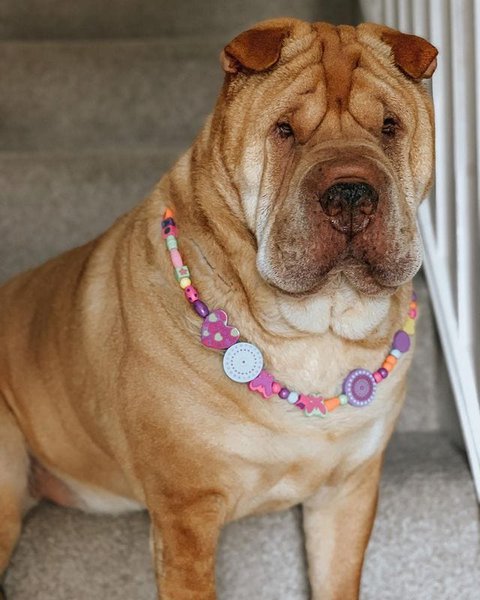
Dogs With Special Diet
If your furry friend is a sensitive breed and can only eat special diet food, you should not feed peanut butter. Because deviating your dog from what it commonly eats can lead to some severe health issues, including an upset digestive system.
Medical Issues
Lastly, if your dog is suffering from any medical issues and is already under the consultation of a vet, then make sure you don’t let your pup eat peanut butter. Otherwise, your pooch will not be able to get healthy again because of fat, oil, and sometimes salt in it.
Which Type Of Peanut Butter Is Best For Dogs?
Unsalted and homemade are the best kinds of peanut butter that you can serve your pup. Because these peanut butter types contain healthy fats, vitamins B and E, niacin, and proteins.
Meanwhile, birch sugar, mostly called xylitol, can be toxic for your pup. Let’s discuss it a bit deeper here.
Unsalted Peanut Butter
Unsalted peanut butter is pretty safe for your furry friend as it comprises less sodium than salted peanut butter which can be problematic for your dog.
Other than that, unsalted peanut butter also comprises fewer fats which do not cause pancreatitis and disturb the digestive system of your furball.
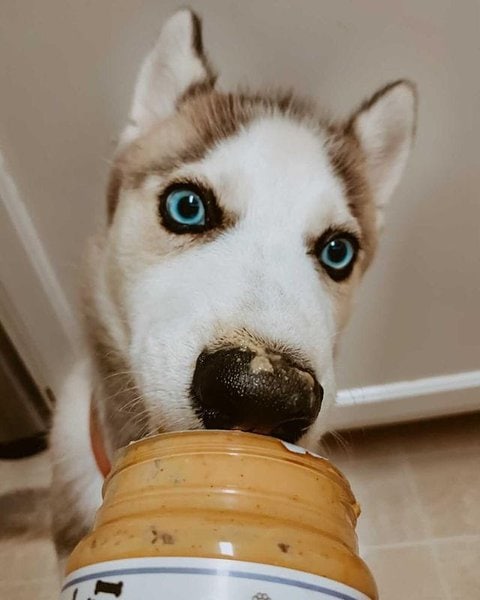
Homemade Peanut Butter
What would be more valuable than peanut butter made at home with love and cautiousness? Homemade peanut butter enables you to control the quantity of sodium and oil added to the mixture. Secondly, it will also help you eliminate birch sugar.
Ingredients
- One and ½ cup of unsalted, roasted peanuts
- One tablespoon chia seeds
- One teaspoon molasses or honey
- One teaspoon or more safflower or peanut oil
Preparation
- Put the peanuts, chia seeds, honey, and peanut oil into the food processor.
- Blend them until the butter comes out in your desired consistency.
- If your dog likes to have crunchy peanut butter, chop ¼ cup of peanuts and gently fold them into the prepared mixture.
- Now, refrigerate it for an hour, and your homemade and healthy peanut butter is ready for your pooch.

